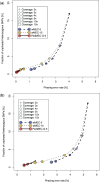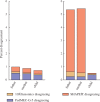Read-based phasing of related individuals
- PMID: 27307622
- PMCID: PMC4908360
- DOI: 10.1093/bioinformatics/btw276
Read-based phasing of related individuals
Abstract
Motivation: Read-based phasing deduces the haplotypes of an individual from sequencing reads that cover multiple variants, while genetic phasing takes only genotypes as input and applies the rules of Mendelian inheritance to infer haplotypes within a pedigree of individuals. Combining both into an approach that uses these two independent sources of information-reads and pedigree-has the potential to deliver results better than each individually.
Results: We provide a theoretical framework combining read-based phasing with genetic haplotyping, and describe a fixed-parameter algorithm and its implementation for finding an optimal solution. We show that leveraging reads of related individuals jointly in this way yields more phased variants and at a higher accuracy than when phased separately, both in simulated and real data. Coverages as low as 2× for each member of a trio yield haplotypes that are as accurate as when analyzed separately at 15× coverage per individual.
Availability and implementation: https://bitbucket.org/whatshap/whatshap
Contact: t.marschall@mpi-inf.mpg.de.
© The Author 2016. Published by Oxford University Press.
Figures




Similar articles
-
trioPhaser: using Mendelian inheritance logic to improve genomic phasing of trios.BMC Bioinformatics. 2021 Nov 22;22(1):559. doi: 10.1186/s12859-021-04470-4. BMC Bioinformatics. 2021. PMID: 34809557 Free PMC article.
-
Read-Based Phasing and Analysis of Phased Variants with WhatsHap.Methods Mol Biol. 2023;2590:127-138. doi: 10.1007/978-1-0716-2819-5_8. Methods Mol Biol. 2023. PMID: 36335496
-
WhatsHap: Weighted Haplotype Assembly for Future-Generation Sequencing Reads.J Comput Biol. 2015 Jun;22(6):498-509. doi: 10.1089/cmb.2014.0157. Epub 2015 Feb 6. J Comput Biol. 2015. PMID: 25658651
-
Integrating read-based and population-based phasing for dense and accurate haplotyping of individual genomes.Bioinformatics. 2019 Jul 15;35(14):i242-i248. doi: 10.1093/bioinformatics/btz329. Bioinformatics. 2019. PMID: 31510646 Free PMC article.
-
Towards accurate, contiguous and complete alignment-based polyploid phasing algorithms.Genomics. 2022 May;114(3):110369. doi: 10.1016/j.ygeno.2022.110369. Epub 2022 Apr 26. Genomics. 2022. PMID: 35483655 Review.
Cited by
-
Dense and accurate whole-chromosome haplotyping of individual genomes.Nat Commun. 2017 Nov 3;8(1):1293. doi: 10.1038/s41467-017-01389-4. Nat Commun. 2017. PMID: 29101320 Free PMC article.
-
Characterizing the rates and patterns of de novo germline mutations in the aye-aye (Daubentonia madagascariensis).bioRxiv [Preprint]. 2024 Nov 11:2024.11.08.622690. doi: 10.1101/2024.11.08.622690. bioRxiv. 2024. Update in: Mol Biol Evol. 2025 Mar 05;42(3):msaf034. doi: 10.1093/molbev/msaf034. PMID: 39605388 Free PMC article. Updated. Preprint.
-
HapCHAT: adaptive haplotype assembly for efficiently leveraging high coverage in long reads.BMC Bioinformatics. 2018 Jul 3;19(1):252. doi: 10.1186/s12859-018-2253-8. BMC Bioinformatics. 2018. PMID: 29970002 Free PMC article.
-
PhaseME: Automatic rapid assessment of phasing quality and phasing improvement.Gigascience. 2020 Jul 1;9(7):giaa078. doi: 10.1093/gigascience/giaa078. Gigascience. 2020. PMID: 32706368 Free PMC article.
-
HaplotagLR: An efficient and configurable utility for haplotagging long reads.PLoS One. 2024 Mar 13;19(3):e0298688. doi: 10.1371/journal.pone.0298688. eCollection 2024. PLoS One. 2024. PMID: 38478504 Free PMC article.
References
-
- Chen Z.Z. et al. (2013b) Exact algorithms for haplotype assembly from whole-genome sequence data. Bioinformatics, 29, 1938–1945. - PubMed
-
- Cilibrasi R. et al. (2007) The complexity of the single individual SNP haplotyping problem. Algorithmica, 49, 13–36.
MeSH terms
LinkOut - more resources
Full Text Sources
Other Literature Sources

